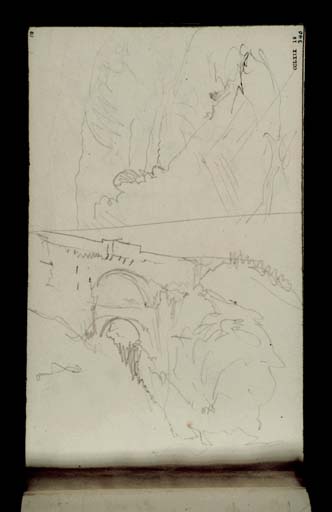Joseph Mallord William Turner Rumbling Bridge, Perth and Kinross, and the River Devon 1834
Image 1 of 2
Joseph Mallord William Turner,
Rumbling Bridge, Perth and Kinross, and the River Devon
1834
Joseph Mallord William Turner 1775–1851
Folio 10 Recto:
Rumbling Bridge, Perth and Kinross, and the River Devon 1834
D26277
Turner Bequest CCLXIX 10
Turner Bequest CCLXIX 10
Pencil on off-white wove paper, 190 x 113 mm
Inscribed in blue ink by John Ruskin ‘10’ top left running vertically and ‘340’ top right running vertically
Stamped in black ‘CCLXIX 10’ top right running vertically
Inscribed in blue ink by John Ruskin ‘10’ top left running vertically and ‘340’ top right running vertically
Stamped in black ‘CCLXIX 10’ top right running vertically
Accepted by the nation as part of the Turner Bequest 1856
References
1909
A.J. Finberg, A Complete Inventory of the Drawings of the Turner Bequest, London 1909, vol.II, p.864, CCLXIX 10, as ‘Bridge across ravine.’.
1974
Martin Butlin, Andrew Wilton and John Gage, Turner 1775–1851, exhibition catalogue, Royal Academy, London 1974, p.126 under no.451.
1990
Frank Milner, J.M.W. Turner: Paintings in Merseyside Collections: Walker Art Gallery; Sudley Art Gallery; Williamson Art Gallery; Lady Lever Art Gallery; Liverpool University Art Gallery, Liverpool 1990, p.68.
1990
Dr David Wallace-Hadrill and Janet Carolan, ‘Turner’s Sketches North of Stirling’, Turner Studies: His Art and Epoch 1775 – 1851, Vol.10 No.1, Summer 1990, p.12.
1990
Dr David Wallace-Hadrill and Janet Carolan, ‘Turner North of Stirling in 1831; a checklist (2)’, Turner Studies: His Art and Epoch 1775–1851, Vol.10 No.2, Winter 1990, p.30 ill.48 in black and white.
While many writers have grouped the two sketches on this page among views of the Falls of Clyde in Lanarkshire (folios 1–12; D26259–D26281),1 the sketch at the left of the page, drawn with the book turned to the left, has been identified instead as depicting the Rumbling Bridge over the River Devon in the village of the same name in the district of Perth and Kinross.2 Like Turner’s other two sketches of the bridge (folios 43 and 43 verso; D26339, D26340), this was made from the northern bank of the river just downstream (south) of the bridge. The shadow beneath the lower arch represents the crevice in the rock through which the river flows after tumbling over Devil’s Mill waterfall.
The sketch on the right side of the page, drawn with the book back in the landscape format, depicts a river and perhaps a small waterfall or rapids as seen from a high river bank. While this subject fits well with the Falls of Clyde group, the fact that it is drawn at the edge of the page, with hardly enough room for such a view, suggests that it is unlikely to have been drawn before the Rumbling Bridge, which Turner visited after his trip to Lanarkshire; see Tour of Scotland for Scott’s Poetical Works 1834 Tour Introduction.
A more likely possibility therefore is the River Devon, and the view downstream towards Cauldron Linn from the same vantage point as the Rumbling Bridge sketch. Folio 43 also carries a sketch of a river than is likely to be the Devon.3
Thomas Ardill
October 2010
How to cite
Thomas Ardill, ‘Rumbling Bridge, Perth and Kinross, and the River Devon 1834 by Joseph Mallord William Turner’, catalogue entry, October 2010, in David Blayney Brown (ed.), J.M.W. Turner: Sketchbooks, Drawings and Watercolours, Tate Research Publication, December 2012, https://www


